Détails
Une révolution pour l’imagerie des gels
Le Système d’Analyse de Fluorescence (Fluorescence Analysis System) FastGene® FAS-DIGI PRO est notre plus récent système d’imagerie pour la détection d’ADN et d’ARN dans les gels d’agarose. Il est le fruit de l’amélioration de notre populaire FAS-Digi (GP-05LED). Equipé d’un appareil photo de 24 MPixel sensible à la lumière, le FAS-DIGI PRO est contrôlé par un logiciel d’imagerie nouvellement développé. Avec le mode d’affichage direct, tous les changements de l’appareil photo, le temps d’exposition, l’ouverture de l’objectif et le zoom digital sont affichés en temps réel. Le FAS-DIGI PRO dispose d’une connectivité complète, permettant un transfert simple des images à un PC.
LED bleu/vert pour une détection sûre de l’ADN et l’ARN
Le FastGene® FAS-DIGI PRO est composé d’un puissant transilluminateur équipé d’une technologie LED bleu/vert unique. Ces LED émettent de la lumière à des longueurs d’ondes comprises entre 470 nm – 520 nm sans endommager les acides nucléiques (Figure 1). Elles permettent la détection de colorants communément utilisés comme par exemple les colorants verts MIDORIGreen ou SYBRTM Green, les colorants jaunes comme SYBRTM Safe et les colorant rouges comme le bromure d’éthidium ou GelRedTM.
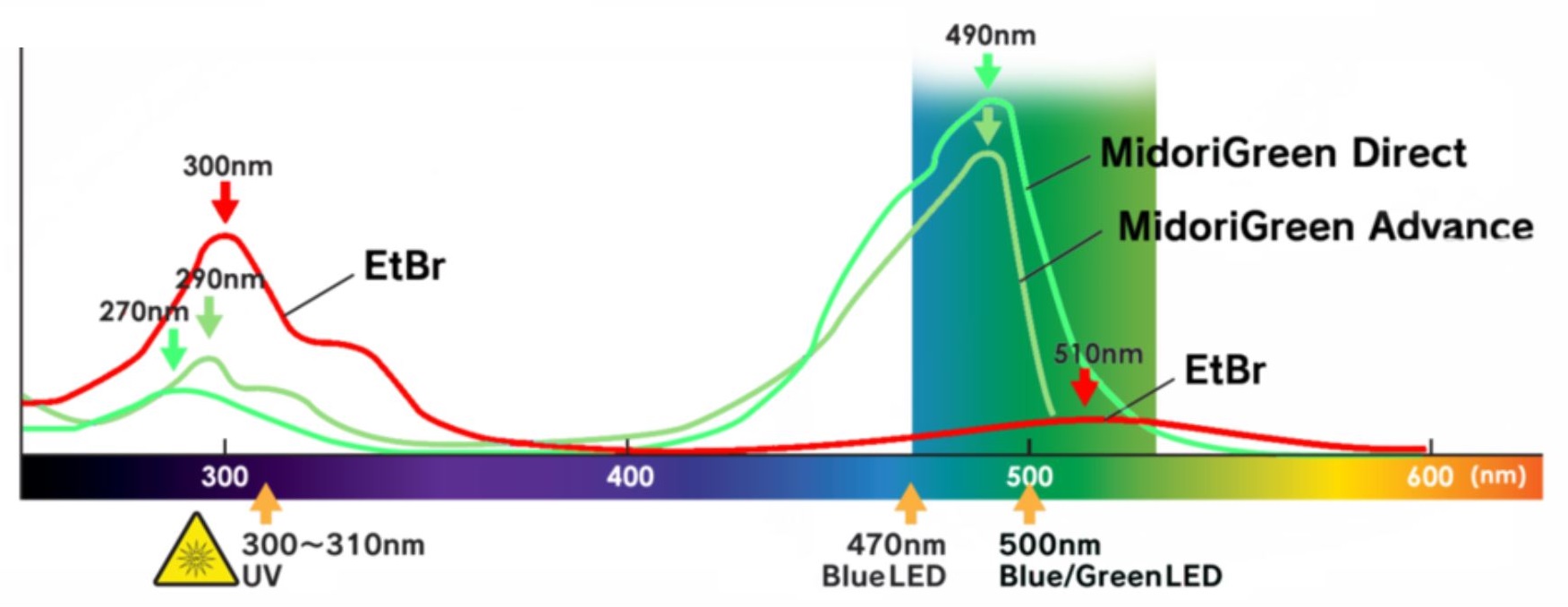
Figure 1 : Spectre d’absorbance du bromure d’éthidium (rouge), MIDORIGreen Advance (vert) et MIDORIGreen Direct (vert clair). Les LED bleu/vert émettent de la lumière pour des longueurs d’onde de 470 – 520 nm, permettant la détection des marqueurs d’ADN verts et rouges couramment utilisés.
La surface d’éclairage du transilluminateur à une taille de 26 x 21 cm ce qui permet l’analyse de plusieurs gels de tailles différentes. Grâce à cette large surface ainsi que la possibilité de retirer le chapeau du Fas-DIGI PRO, il est très facile d’exciser les bandes d’ADN (Figure 2). La combinaison de notre technologie unique avec des composants de hautes qualités en font un appareil optimal pour de meilleurs résultats.

Figure 2 : Le chapeau du FAS-DIGI PRO peut facilement être enlevée. Cela permet une excision facile des bandes d’ADN.
Logiciel d’imagerie intuitif
Le FastGene® FAS-Digi PRO est fourni avec le logiciel NIPPON Genetics Camera studio. Il permet de contrôler tous les paramètres de l’appareil photo pour analyser de façon optimale les images : il suffit d’ajuster l’ouvertutre, le temps d’exposition, la sensibilité et le focus afin de créer des images d’une très grande qualité. Le focus peut être contrôlé grâce à la molette de la souris. De plus, il est possible de sélectionner et d’élargir la zone d’intérêt en utilisant la souris. Les images peuvent être enregistrées aux formats TIFF et JPEG. Pour l’impression il suffit d’utiliser une imprimante connectée à l’ordinateur. A ce titre nous vous recommandons Mitsubishi Thermal Printer (P95DE), qui créera des impressions remarquables sur du papier ultra-brillant.
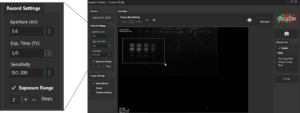
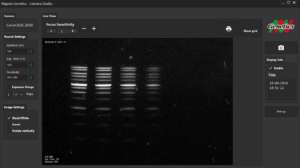
Optimisez et analysez vos images avec le logiciel NIPPON Genetics Camera studio. Vous pourrez contrôler en temps réel les paramètres de l’appareil photo, l’ouverture, l’exposition et la sensibilité. La fonction zoom sur les gels d’agarose est facilement contrôlable via la souris de l’ordinateur.
Appareil photo pour des images de grande qualité
Prenez des images de très grande qualité en utilisant le Canon. Cet appareil photo a un immense capteur APS-C CMOS avec un diamètre de 22,3 x 14,9 et ne produit pas de bruit de fond visible pour des ISO de 100 à 1600. De plus, les 24 megapixels permettent la détection des signaux les plus faibles dans les gels d’agarose.
Le temps d’exposition du capteur varie de 1/4000 sec jusqu’à 30 sec. Un temps d’exposition très bref vous garantira une visualisation dans la plage dynamique des bandes d’ADN les plus lumineuses. Au contraire, un temps d’exposition long jusqu’à 30 secondes vous permettra de visualiser les bandes les plus faiblement lumineuses. Le zoom 3x (longueur de la focale de 18 mm à 55 mm), vous permettra de visualiser parfaitement la zone d’intérêt : à 18 mm, vous pourrez prendre une photo de toute la zone illuminée alors qu’à 55 mm vous pourrez éliminer les zones non voulues.
L’appareil photo est directement connecté à la source d’alimentation du FAS-DIGI PRO. Il est donc en permanence alimenté.
Il n’est plus nécessaire de remplacer la batterie.
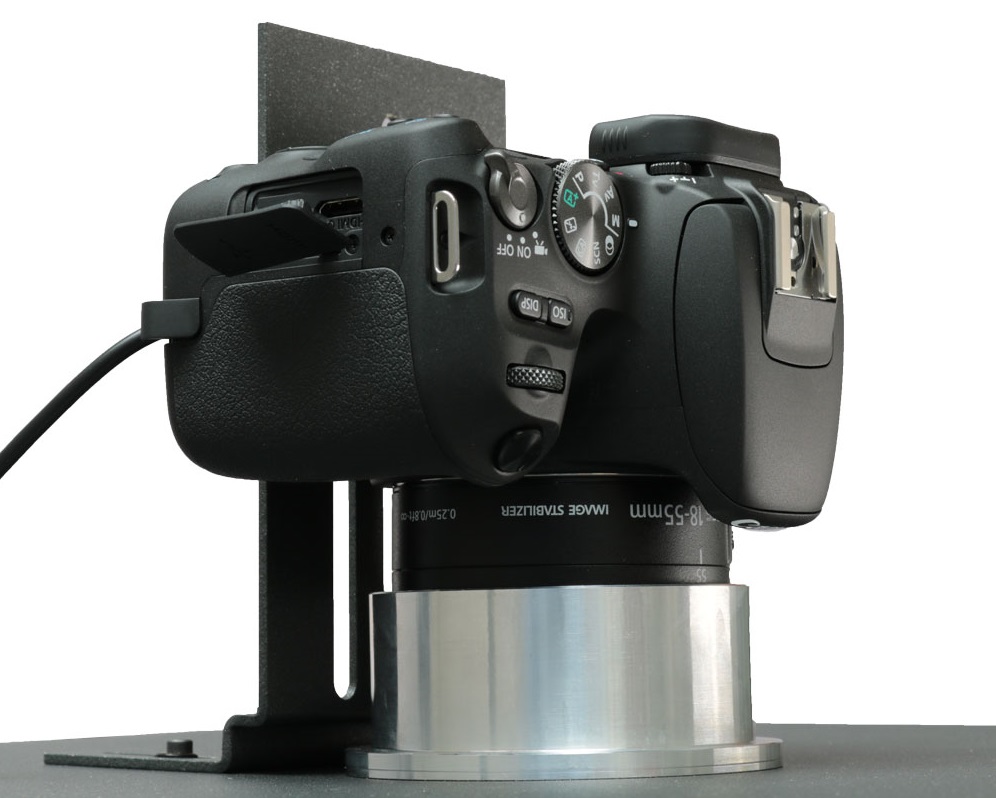
L’appareil photo sensible à la lumière du FAS-DIGI PRO possède 24 megapixels et un capteur APS-C CMOS, permettant une analyse de grande qualité des gels d’agarose.
Demander une démonstration ou un devis gratuit
Vous souhaitez obtenir plus d’informations sur des questions techniques ou sur le logiciel ? Vous êtes intéressé par une démonstration en direct ? Prenez contact avec nous !

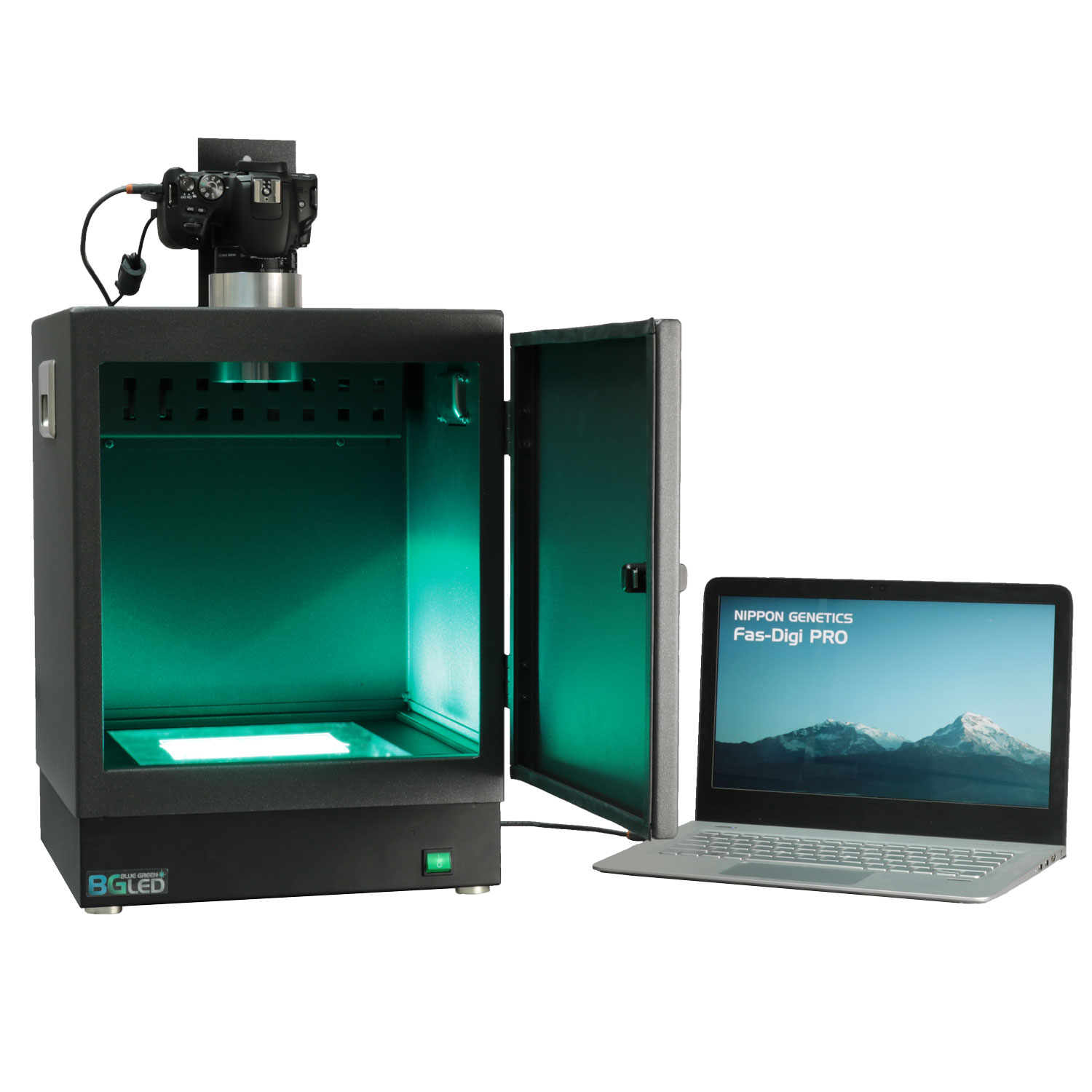
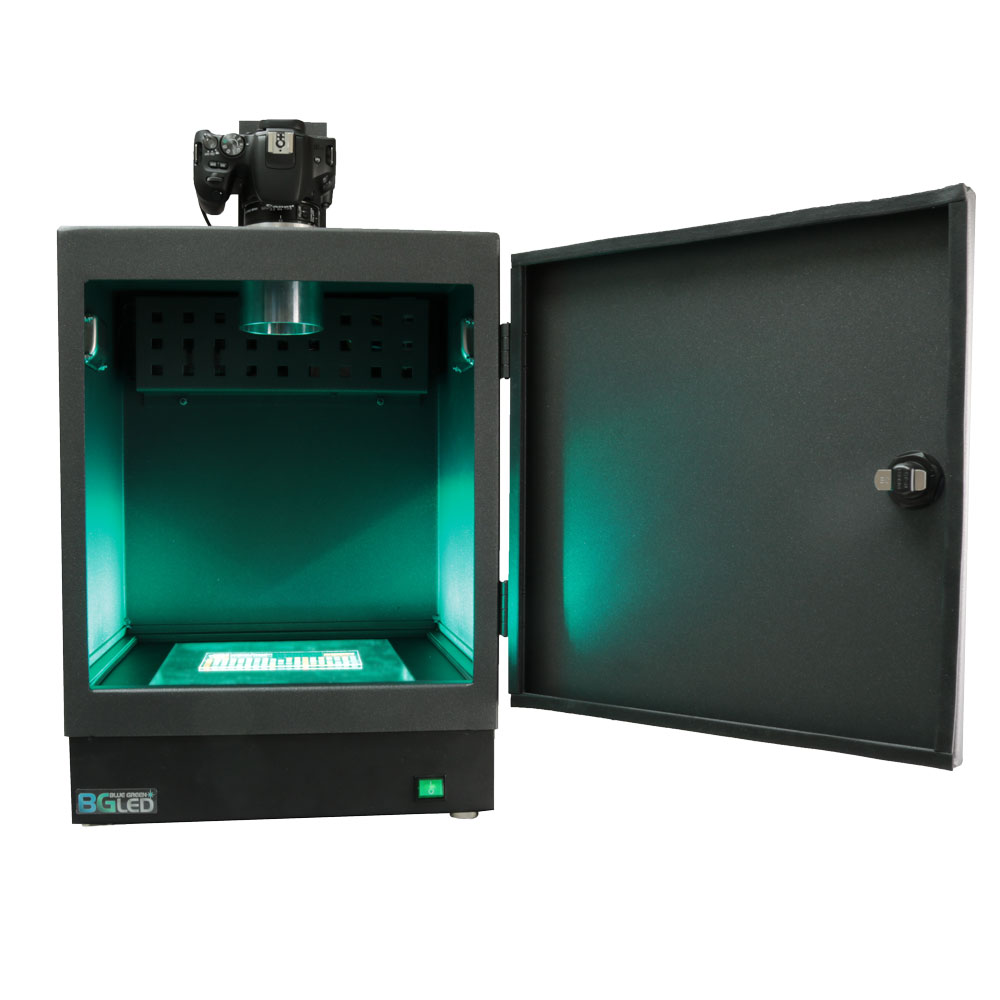



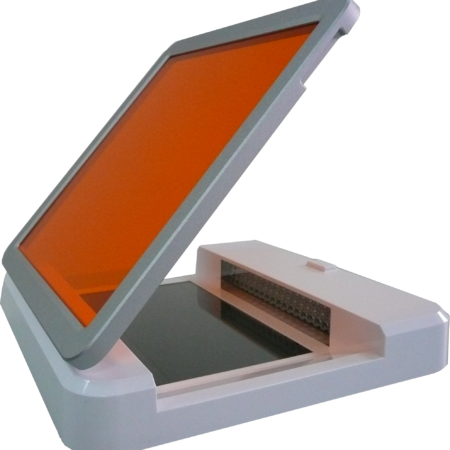
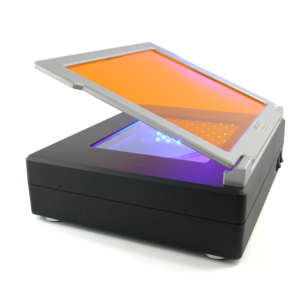
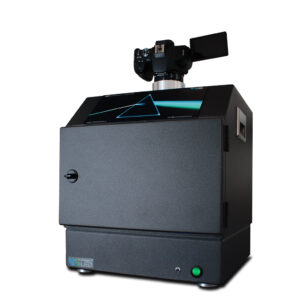
Dr. Thomas Göttlinger, Molekulare Pflanzenforschung/Pflanzenbiochemie, Bergische Universität Wuppertal –
Wir haben jahrelang Ethidiumbromid genutzt, waren aber mit den Ergebnissen nicht mehr zufrieden und wollten aus Sicherheitsaspekten ein ungefährlicheres und aktuelleres System nutzen. Bei unserer Recherche sind wir auf die FAS-DIGI PRO mit dem Farbstoff Midori Green gestoßen. Nach einer äußerst professioniellen Vorführung des Geräts waren wir mit der Handhabung und den Ergebnissen sehr zufrieden. Deswegen haben wir uns für dieses System entschieden und nutzen die FAS-DIGI PRO nun schon einigen Wochen. Der Aufbau der FAS-DIGI PRO war sehr einfach und verständlich. Die Software ist einfach zu bedienen und die Kamera liefert sehr gute Bilder. Durch den Farbstoff Midori Green Xtra können wir bei DNA und auch RNA-Proben besonders gute Banden erzielen, die sogar Gele behandelt mit Ethidiumbromid übertreffen. Aufgrund dessen sind wir mit der FAS-DIGI PRO vollends zufrieden und können diese bisher bedenkenlos weiterempfehlen.
Translated by NIPPON Genetics EUROPE
We had been using ethidium bromide for years, but were no longer satisfied with the results and wanted to use a safer and more up-to-date system for safety reasons. During our research we came across the FAS-DIGI PRO with the Midori Green dye. After a very professional demonstration, we were very satisfied with the handling and the results. We have been using the FAS-DIGI PRO for several weeks now. Setting up the FAS-DIGI PRO was very simple and easy to understand. The software is easy to use and the camera delivers very good images. Thanks to the Midori Green Xtra dye, we are able to obtain particularly good bands for DNA and RNA samples, which even outperform gels treated with ethidium bromide. As a result, we are completely satisfied with the FAS-DIGI PRO and have no hesitation in recommending it.
Utilisateur vérifié
Dr. Karin Hage-Ahmed Universität für Bodenkultur Wien/University of Natural Resources and Life Sciences Vienna Department für Nutzpflanzenwissenschaften/Department of Crop Sciences Institut für Pflanzenschutz/Institute of Plant Protection –
Für unsere phytopathologischen Fragestellungen haben wir ein möglichst einfaches aber auch sehr funktionales Geldokumentationssystem gesucht. Das FastGene FAS Digi Pro System konnte uns sowohl durch den einfachen und modularen Geräteaufbau als auch durch die sehr intuitive Kamerasoftware, die eine schnelle Optimierung der Aufnahmeparameter erlaubt, überzeugen. Durch die gegebene Netzwerksfähigkeit können die erstellten Bilder auch sehr einfach in unsere Netzlaufwerke übertragen werden. Zusätzlich hat uns auch die Blue/Green LED Licht Technologie überzeugt, die es uns nun ermöglicht grüne DNA-Farbstoffe (und andere) zu detektieren ohne dabei Nukleinsäure schädigendes UV-Licht zu verwenden.
Translated by NIPPON Genetics EUROPE:
Dr. Karin Hage-Ahmed, University of Natural Resources and Life Sciences Vienna, Department of Crop Sciences, Institute of Plant Protection
For our phytopathological questions, we were looking for a gel documentation system that was as simple as possible but also very functional. The FastGene FAS-DIGI PRO system impressed us with both, its simple and modular device design and its very intuitive camera software, which allows the recording parameters to be quickly optimized. Thanks to the network capability the created images can also be easily transferred to our network drives. We were also impressed by the Blue/Green LED light technology, which now enables us to detect green DNA dyes (and others) without using UV light that damages nucleic acids.
Utilisateur vérifié
Institut für Muskuloskelettale Medizin, Universitätsklinikum Münster –
Wir haben das Gerät seit ein paar Monaten in Gebrauch und sind damit sehr zufrieden. Die Handhabung ist einfach und das Gerät macht gute Bilder. Dadurch das kein UV-Licht verwendet wird, ist es wesentlich angenehmer Banden aus dem Gel auszuschneiden. Jedoch ist es schwieriger die Banden genau auszuschneiden, da man nicht direkt von oben auf das Gel schauen kann, ohne die Dunkelkammer zu entfernen.
Bei der Software würden wir uns noch ein Beschriftungstool wünschen, um die Gele direkt beschriften zu können.
Translation by NIPPON Genetics EUROPE:
We have been using the instrument for a few months and are very satisfied with it. The handling is easy and the instrument takes good pictures. Since no UV light is used, it is much more pleasant to cut bands out of the gel. However, it is more difficult to cut out the bands precisely because you cannot look directly at the gel from above without removing the darkroom. With the software, we would still like a labeling tool to be able to label the gels directly.
Utilisateur vérifié
Dr. Stefano Pepe, TIGEM, Italy –
This Gel Doc equipment is really user friendly and the quality/price rate is really fair compared to the historic system like Bio-Rad, etc. You don’t need laptop or desktop to check and download your images… an app by Canon is enough. The Blue light is really powerful and avoids all the problems linked to UV lamp. A solid and less expensive alternative to the competitors.
Utilisateur vérifié
Dr. Tanja Rehders, Botanisches Institut, Christian-Albrechts-Universität zu Kiel –
Wir haben das FastGene FAS-Digi PRO seit einiger Zeit in Gebrauch und sind sowohl mit der benutzerfreundlichen Handhabung der Software, wie auch der Qualität der Aufnahmen sehr zufrieden. Wir verwenden als Farbstoff Ethidiumbromid, womit DNA im Gel sehr gut detektierbar wird. Von uns wurden keine nennenswerten Unterschiede zur Detektion mit herkömmlichen UV-Transilluminatoren festgestellt.
Lediglich das Ausschneiden von Banden aus einem Gel gefällt uns an dem System nicht so gut. Die vom Hersteller vorgesehen Entfernung der Dunkelkammer empfinden wir als etwas unhandlich. Wir haben uns zu diesem Zweck einen selbstgebauten Amber-Filter oben an der Kammer befestigt, der jetzt bei Bedarf heruntergeklappt werden kann. Mit dieser Modifikation gefällt uns das Geldokumentationssystem sehr gut und können es mit gutem Gewissen weiterempfehlen.
Translation by NIPPON Genetics EUROPE:
We have been using the FastGene FAS-Digi PRO for some time now and are very satisfied with the user-friendly handling of the software and the quality of the recordings. We use ethidium bromide as a dye, with which the DNA detection is very good. We did not find any significant difference in signal to the detection using conventional UV transilluminators.
Only the cutting out of bands from a gel we like the system could be optimized. The removal of the darkroom provided by the manufacturer is perceived as being somewhat unwieldy. For this purpose, we have attached a self-made amber filter to the top of the chamber, which can now be folded down if necessary. With this modification, we like the gel documentation system very well and can recommend without hesitation.
Comment from NIPPON Genetics EUROPE:
Thank you very much for your honest feedback. We follow your recommendation. The current version of the FAS-Digi PRO comes with an amber shield, which can be attached with magnets inside the box. Cutting out DNA bands is now very easy without removing the hood.
Furthermore, the new version of the FAS-Digi PRO comes also with a white light source for the visualization of petri dishes and protein gels. For this purpose, you just have to remove the amber filter from the lens.
Utilisateur vérifié
Prof. Dr. Olivia Masseck, Synthetische Biologie, Universität Bremen –
Wir arbeiten nun seit einigen Monaten zu unserer großen Zufriedenheit mit dem FastGene FAS-Digi Pro in Kombination mit dem Farbstoff Midori Green. DNA Proben sind sehr gut detektierbar und dank der mitgelieferten Software sind leicht und schnell sehr gute Bilder gemacht. Einziges Manko: Zum Ausschneiden von Gelbanden, wäre ein beiliegendes Plexiglas, das durch eine Erhöhung einer Seite schief in der Kammer liegt von Vorteil, da man so in einem 90° Winkel auf das Gel gucken kann und somit genauere Schnitte durchführen werden könnten. Das Geldokumentationssystem erfüllt bis auf diesen Punkt alle unsere Erwartung. Wir würden das FastGene FAS-DIGI jederzeit weiterempfehlen.
Translation by NIPPON Genetics EUROPE:
We have been working for a few months with the FastGene FAS-Digi Pro with great satisfaction using the dye Midori Green. DNA samples are very easy to detect and thanks to the supplied software, very good pictures are taken quickly and easily.
The only drawback: To cut out gel bands, an enclosed Filter, which is attached to the system´s chamber could be advantageous because you can look at a 90 ° angle to the gel and thus more accurate cuts could be performed.
The gel documentation system meets all our expectations to this point. We would recommend the FastGene FAS-DIGI Pro at any time.
Comment from NIPPON Genetics EUROPE:
Thank you very much for your honest feedback. We follow your recommendation. The current version of the FAS-Digi PRO comes with an amber shield, which can be attached with magnets inside the box. Cutting out DNA bands is now very easy without removing the hood.
Furthermore, the new version of the FAS-Digi PRO comes also with a white light source for the visualization of petri dishes and protein gels. For this purpose, you just have to remove the amber filter from the lens.s
Utilisateur vérifié